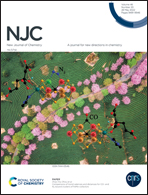Improved performance of immobilized laccase for catalytic degradation of synthetic dyes using redox mediators†
Abstract
Laccase is an important biodegradation agent as the catalytic degradation could be enhanced in the presence of redox mediators. This work aims to improve the removal performance of immobilized laccase for high concentrations of synthetic dye degradation using 2,2′-azinobis(3-ethylbenzothiazoline-6-sulfonate) (ABTS), 2,2,6,6-tetramethylpiperidine-1-oxyl (TEMPO) and violuric acid (VLA) as redox mediators. The laccase was immobilized on magnetic hydroxyl-functionalized Fe3O4 nanoparticles (Fe3O4–PEG 2000–Cu2+) based on Cu2+ chelation. The immobilized laccase presented relatively high immobilization capacity and activity retention, improved thermostability and pH tolerance, and excellent reusability. The removal performance assay reveals that the immobilized laccase had high and sustainable removal efficiencies for high concentrations of triphenylmethane dyes in the presence of these redox mediators. It should be mentioned that azo and anthraquinone dyes at concentrations of 25–200 mg L−1 could be rapidly oxidized by the immobilized laccase using these mediators in 20–30 min. A recycling degradation study showed that after 10 catalytic runs, the removal efficiency of triphenylmethane, azo and anthraquinone dyes by the immobilized laccase employing these mediators could still reach 78.3–99.9 (%), 63.1–94.6 (%) and 60.5–74.6 (%), respectively. The outstanding dye degradation performances show that the immobilized laccase has a potential application in wastewater treatment and environmental protection.



 Please wait while we load your content...
Please wait while we load your content...